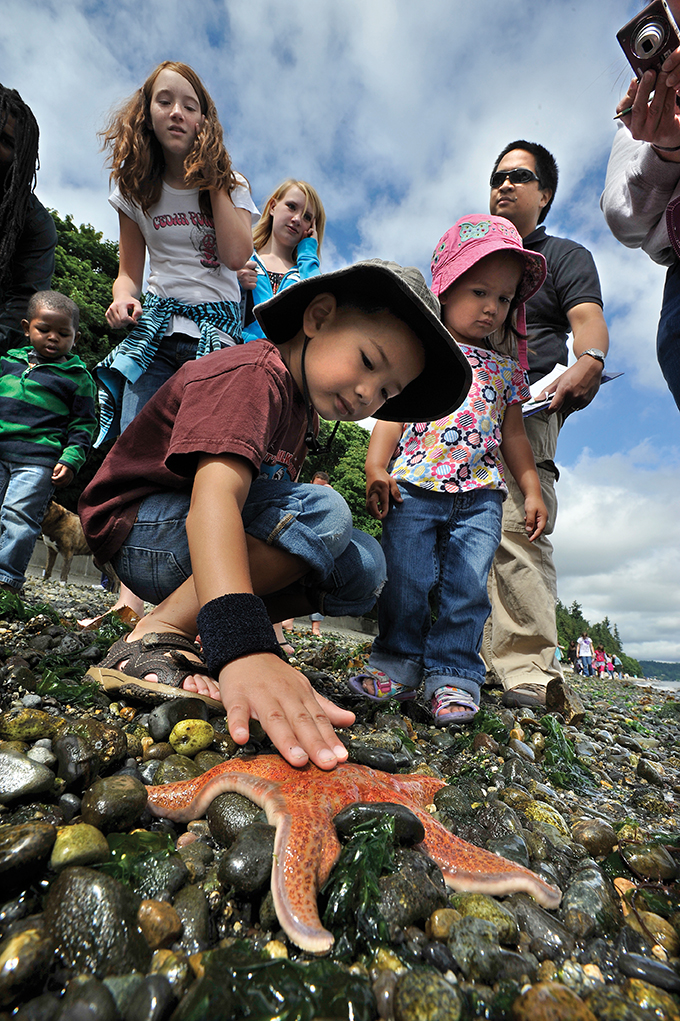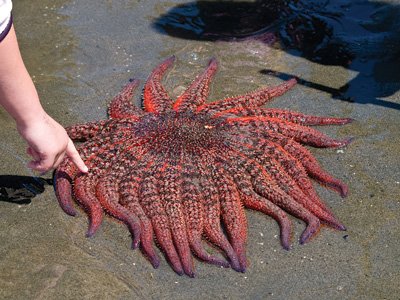
(Editor’s note: Also check the ParentMap calendar for upcoming low-tide walks throughout the Sound.)
Spring and summer are prime beach walking times in Puget Sound. Every two weeks, the cycle of the moon creates several days of very low tides during the midday hours. This coincides with warming weather and winter-weary residents, and it seems that everyone flocks to the beaches.
Before I worked in Edmonds as a park ranger I didn’t know much about when and where to go, and I didn’t know anything about the rules I needed to follow. So I’m passing on to you what I’ve learned over the years about beachcombing planning and etiquette. Though we live in Puget Sound, these tips are relevant almost anywhere!
1. Know your minus tides
First off, you need to find when the low tides are for your area. In Puget Sound, we have two low and two high tides every day. The tides shift by about 20-30 minutes each day. One set of lows is lower than the other set. The best tides for beach walking are minus tides, where the measurement is below 0. About the lowest we get in Edmonds is -4.0, but that doesn’t happen every year. Minus 2s or 3s are when you can find the coolest critters. There are several ways you can find out the low tides. You can pick up a paper tide guide for your area for the whole year.
Or you can go online; the site I use most often is ProTides. You can view the tides graphically or in chart format. Search and click on your location; make sure you look specifically for the area you plan to go, as the times of the lowest lows change depending on location. The best beach walking is an hour before and after the lowest time (that time extends longer for the lowest tides).

2. Find a beach naturalist (and a great beach)
Many beaches have naturalist programs during low-tide events or on weekends in the summer. You’ll learn a lot by following along with a ranger or trained volunteer -- and their calendar is also a easy guide to low-tide days! You can find programs in Edmonds. Seattle-area beaches are staffed by volunteers from the Seattle Aquarium Beach Naturalist program; see here for their schedule and locations. The South Sound Estuary Association has many programs on beaches in the south end, as does Tacoma Nature Center and Point Defiance. Up north, the Port Townsend Marine Science Center has some walks scheduled near their facility. The Breazeale Interpretive Center at Padilla Bay also has walks and classes for toddlers through adults.
3. Learn the rules
Many urban beaches have been protected as marine sanctuaries. Therefore, they have stricter rules than other beaches. Before you head out to a certain beach, you need to know the rules. Are dogs allowed? Will you be allowed to collect shells or rocks and take them home? Can you bring a barbecue? If you’re going to a state park you’ll need a Discover Pass to park. Pay attention to signs at the beach when you arrive. Don’t trespass onto bordering private land. Coming from the necessarily protective Puget Sound down to Oregon last year, we were thrilled that all the beaches were public and that it wasn’t against the rules to bring home an agate or shell.
 4. Be gentle and aware
4. Be gentle and aware
Animals that are exposed at low tide are under an extreme amount of stress. They are adapted to living in cool, moving water, and suddenly are thrust into the warm, dry air. Most critters can handle a bit of gentle touching, but they won’t want to be carried around in a toddler’s over-eager hands for very long. If you do touch an animal, wet your fingers in seawater first. We like to turn over rocks to look for animals hiding underneath; stick to smaller rocks to avoid crushing creatures on top of larger boulders. Walk around eelgrass beds and large areas of seaweed so that you don’t step on anything that might be hiding underneath. Gently lift fronds of seaweed; you might be surprised at what you’ll find! Be sure to put any animals you find back in the home they came from. Don’t pry critters off of rocks if they are stuck very firmly.
5. Be safe
Most animals in Puget Sound waters will not hurt us. There are some, however, that could cause injury. The more serious is Lion’s Mane jellyfish; they are larger jellyfish with red or yellowish centers. Large crabs can pinch severely; I give my children the guideline to only pick up crabs that fit into a circle they make with their thumb and first finger.
Octopuses can give a painful, toxic bite with their beaks. I insist my children wear some kind of shoes – rubber boots, sandals or water shoes. Barnacles and shell fragments (not to mention trash) can slice tender feet. And that water is cold! Puget Sound water this time of year is the upper 40s, and even in the summer months is only in the mid 50s.
Use caution when climbing on rocks, both to protect fragile sea life and fragile ankles and knees. Pay attention to when the tide starts turning back in, so you don’t get stuck on a sand bar far from shore. Watch for mud that can suck your boots off and cause you to sink.
6. Be prepared
As with any activity, you’ll have more fun if you are prepared for the conditions. My fair-skinned children know our family policy is to wear sun hats and sunscreen on the beach – unless it’s raining, when we’ll wear rain gear. We bring a sheet or blanket to sit on, snacks and cold water, a small first aid kit, towels (because you can’t keep a kid from getting wet and sandy at the beach!), lip balm, long-sleeved shirts or sweaters to protect from marine breezes, and of course, toys to play with. A change of clothes for the ride home will help you relax about your kids getting dirty. We like to bring our field guides, too, to identify what we see.
7. Learn on your own
Some of the resources my kids and I have used to identify what we see are the following:
- The Beachcomber’s Guide to Seashore Life in the Pacific Northwest, by J. Duane Sept
- Marine Wildlife From Puget Sound Through the Inside Passage, by Steve Yates
- Common Intertidal Invertebrates of the Salish Sea; a set of laminated cards with color photos, from Periwinkle Press
- Buzz’s Marine Life of Puget Sound is a fabulous blog that helped me identify some of the eggs I’ve found on the beach. (Warning: I've seen occasional crude language -- you might want to do a preview before letting your kids loose on the site.)
The low-tide beach walks are some of our favorite outdoor outings each spring. We feel so fortunate to live in a place where we can enjoy the salt water and the animals that live in it.
Do you have a favorite beach for exploring during low tides? Let us know in the comments!











